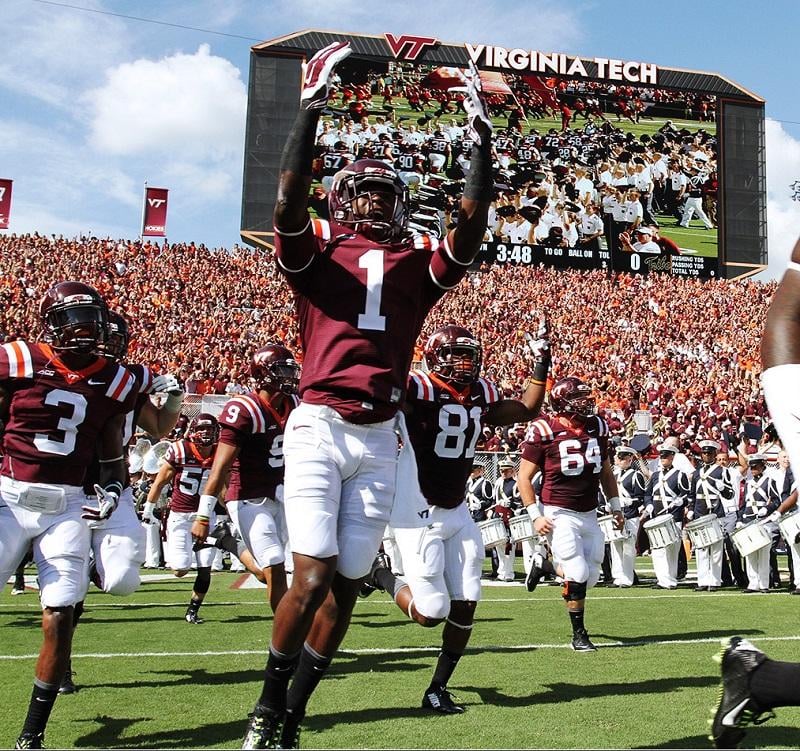
How much do Virginia Tech students pay in athletic fees, and how does it compare to other state schools and the ACC?
With athletic departments being faced with Cost of Attendance and other rising expenses, student athletic fees have become a hot topic, and we’ll clear up the picture for you with this article.
Before we get started, one very important point: the data presented in this article is for fiscal year 2014 (FY2014), which is “last year,” the academic year 2013-14. Most of the sources and reports we need to compile our data lag by one year, so note that our data isn’t from the current 2014-15 academic year (FY2015).
For example, we’ll talk about how Virginia Tech’s student athletic fees are $273 per year, and in FY2014, that was correct. But it should be noted that for the current academic year (FY2015), they rose to $282 per year.
What is a Student Athletic Fee?
Since we’ll be talking about student athletic fees in this article, we must first define what student athletic fees are.
Every student pays mandatory “tuition and fees” to attend a college or university. The “tuition” part speaks for itself; it pays directly for the instruction and education-related component. The “fees” that students pay encompass a variety of goods and services. Some of the fees are called “E&G” (Education and General) fees and are also related to the instruction and education-related component.
Then there are the mandatory “non-E&G” fees, which are used to support non-instructional activities, such as student health services, recreational activities, campus transportation, capital debt service … and athletics.
For example, here are Virginia Tech’s non-E&G fees for 2013-14:
- Athletics: $273
- Bus and Escort: $123
- Health Service: $372
- Recreational Facilities: $273
- Student Activity: $464
- Student Services – Annual: $247
- Total non E&G fees: $1,752
This article is about the portion of student fees that solely go to support athletics, and in the case of a Virginia Tech student, that portion was $273 in 2013-14.
Now, on to the data. We’ll present some infographics, created by OXVT as always. (Say it with me: follow him on Twitter; push him over 1,400 followers!) As always, click the infographics for a larger version.
We’ll focus on comparing Virginia Tech to its peer in-state “Power 5” athletic institution, the University of Virginia, as well as fellow FBS football school Old Dominion, and the following Division 1 athletic universities and colleges that do not play FBS football: James Madison, VCU, George Mason, William & Mary, and Radford.
Breaking Down In-State Athletic Fees
Let’s start with the infographic with the most impact.
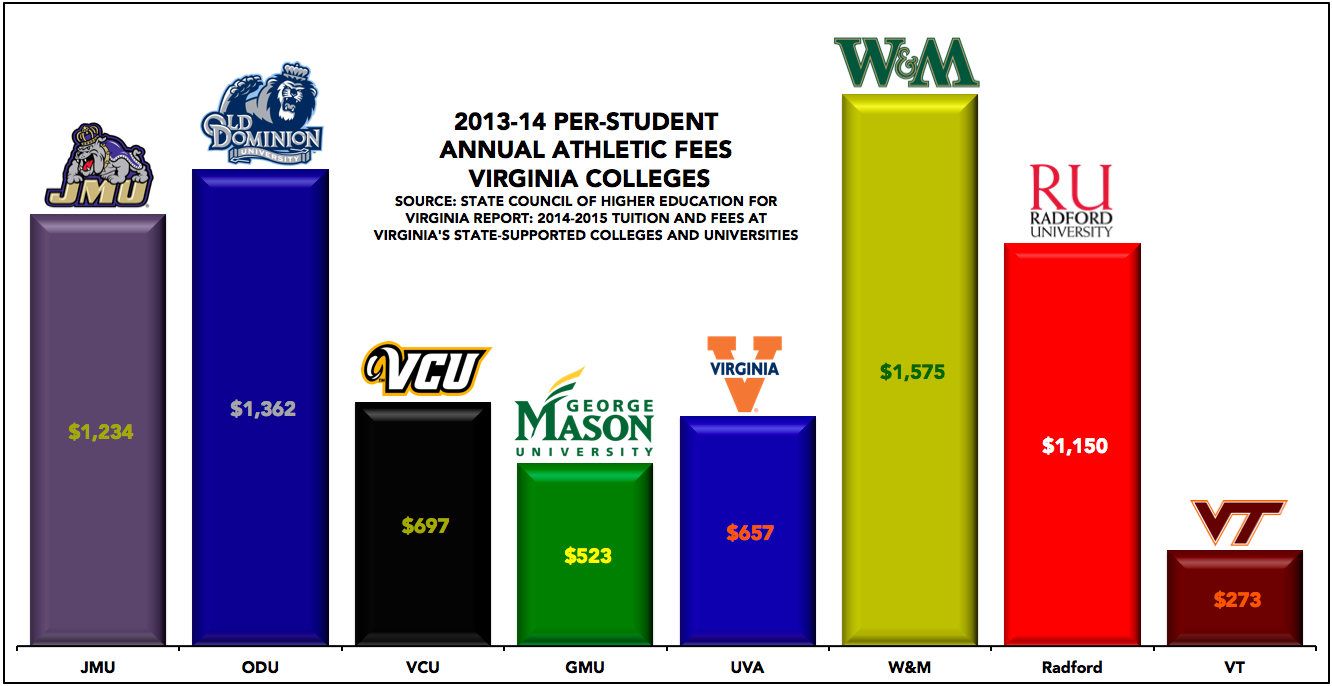
There it is, in living color: Virginia Tech’s athletic fees are much lower than any other college or university in the state.
The Hokies charge barely half what the next-lowest school, George Mason, charges, and as you compare VT to other state institutions, the difference rapidly approaches a factor of 3:1 and reaches a high of almost 6:1 when compared to William & Mary.
For whatever historical and political reasons, that’s the landscape and the position that Virginia Tech occupies.
What happens when you factor in the number of students who pay the athletic fee?
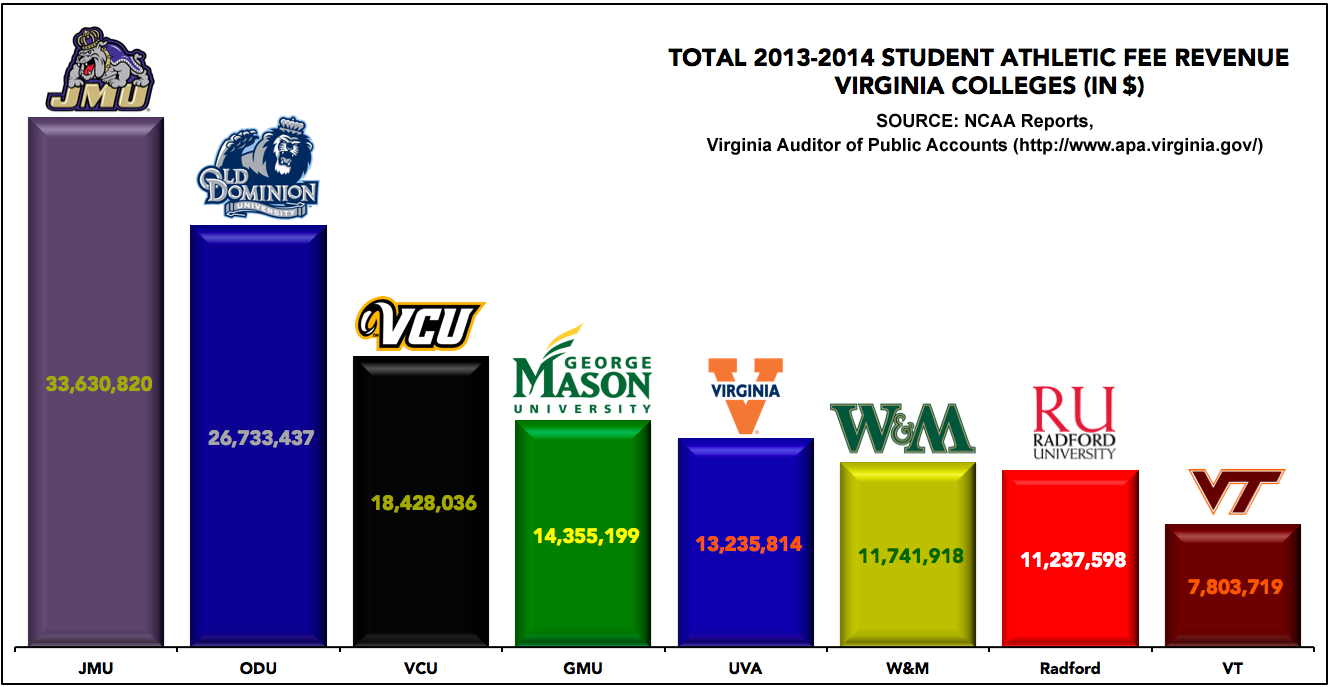
When you examine total student athletic fee revenue, Virginia Tech’s position improves with regards to its fellow state institutions, but not by much.
Of particular interest is VT’s athletic fee revenue versus their peer Power-5 school and fellow ACC member, the University of Virginia. UVa’s undergraduate enrollment (listed as 14,898 on UVa’s web site) is far less than Virginia Tech’s undergraduate enrollment of 24,179 (listed on VT’s web site), but their higher per-student fee $657 vs. $273) leads to a total athletic fee revenue advantage of over $5.4 million.
In the latest Virginia Tech Athletics Financial Report provided by Randy Jones, UVa’s total FY2014 athletic revenues were reported at $83.7 million, whereas Virginia Tech’s were $73.1 million. UVa enjoyed a revenue advantage of $10.6 million, just over half of which came from student athletic fees.
What percentage of athletic revenue at Virginia colleges comes from student fees?
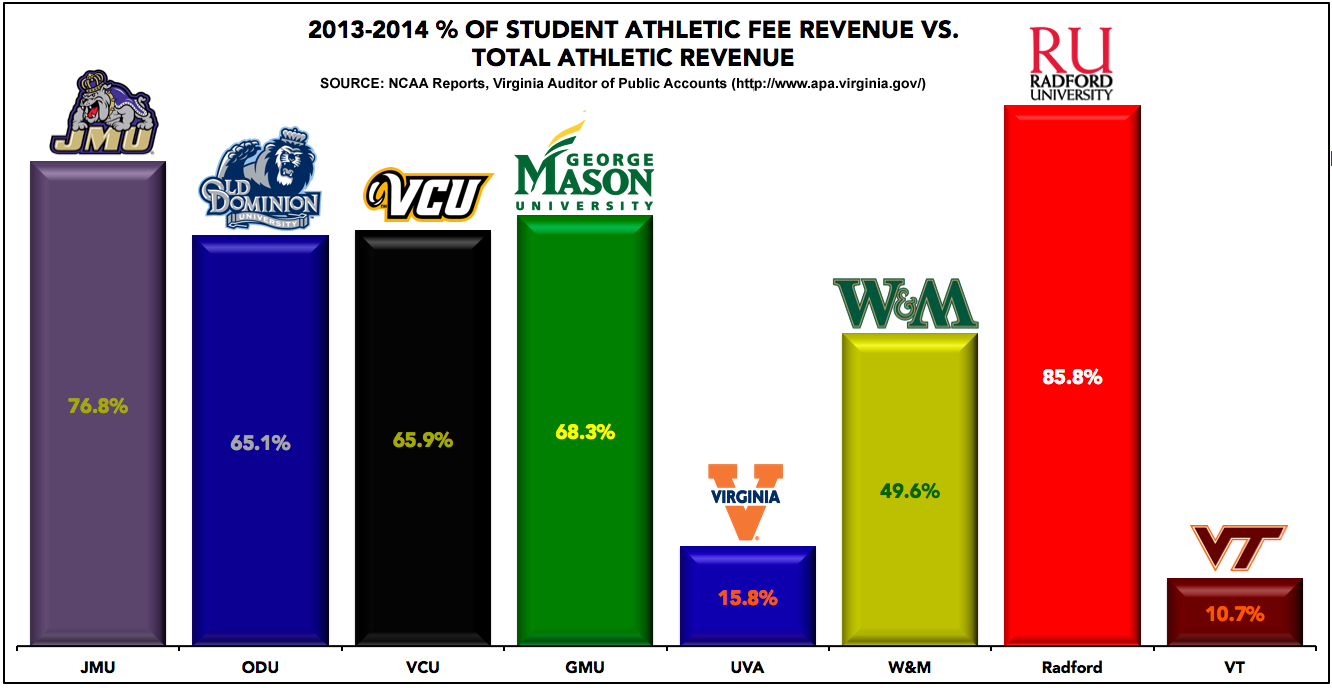
Here’s a look at total revenue and athletic fee revenue in simple table form.
Virginia Tech’s percentage is low, even when compared to UVa. It’s normal for smaller athletic departments with non-Power 5 football programs (or no football at all) to derive a large percentage of athletic revenue from student fees, so the high percentages shown by JMU, ODU, VCU, et al are not surprising.
Historically, Virginia Tech’s percentage of student athletic fee revenue vs. total athletic department revenue has essentially remained unchanged for six years now, and is lower than it was back when the Hokies first entered the ACC.
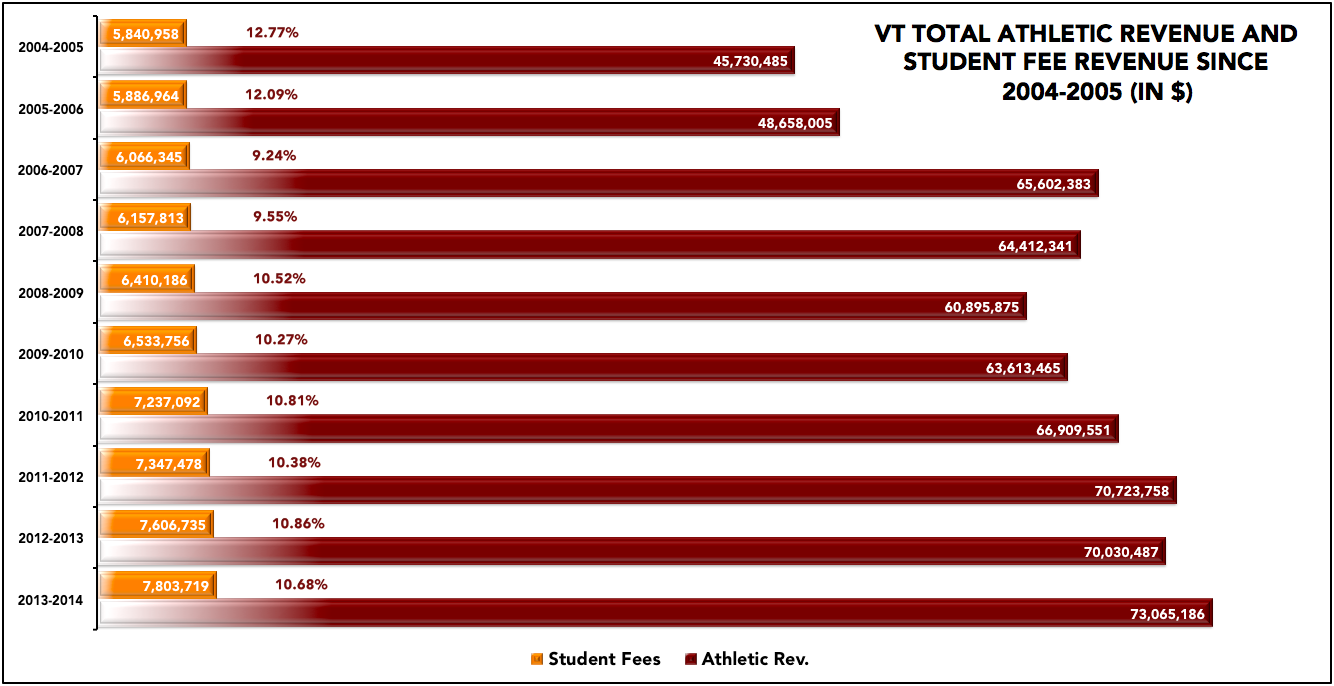
Comparison: Virginia Tech to ACC Schools
Calculating similar numbers and comparing Virginia Tech to ACC schools would be difficult and beyond the scope of what we’re doing here. Of the ACC’s 15 schools, six are private and are not required to disclose financial data to the public. Another, Pittsburgh, is not required by the Commonwealth of Pennsylvania to provide financial data for public consumption. Not to mention that ACC schools reside in nine different states, so simply finding the data would be difficult, and its presentation would be inconsistent.
I did ask Randy Jones to find out what he could, and he answered with this:
- BC – Student athletic fees are funded from a student activity fee of $324/year. The breakout specifically for athletics is not available. Approximately 20% of the BC athletic budget is funded from student fees.
- Clemson – no fees; however there is serious consideration of charging $350/year beginning next year. The athletic budget is stressed already, plus the COA is going to make it worse.
- FSU – $7.90/credit hour which works out to $237/year for two 15 credit hours per semester.
- Georgia Tech – $254/year
- Miami – $144/year
- NC State – $232/year
- UNC – $279/year
- Pitt – none at the Pittsburgh campus
- Syracuse – none
- Louisville – $100/year
- Duke, Notre Dame, Wake Forest – none specifically reported
Based on that rapid research, Virginia Tech’s fees are comparable to or higher than many schools in the ACC. UVa’s fees of $673 are much higher, so their relationship to other schools in the ACC is similar to their relationship to Virginia Tech; they enjoy an advantage.
Coming tomorrow: House Bill 1897, its impact on athletic fees, and a poll: Should Virginia Tech raise student athletic fees?
This article is free, but please consider supporting TechSideline.com and unlocking all our great pay content with a TSL Pass subscription. Click here to sign up, and click here for details on our 6-month, $20 new subscriber promotion, available through the end of May.
Data Sources
Many thanks to Randy Jones for compiling data from the Virginia Auditor of Public Accounts (APA) web site.
Some data was also compiled from the report “2014-15 Tuition and Fees at Virginia’s State-Supported Colleges and Universities” produced by the State Council of Higher Education for Virginia. The report is interesting reading. It’s in PDF form and can be downloaded by clicking here.
Many thanks to OXVT for providing infographics from compiled data.
Many thanks also to a friend who wishes to remain anonymous, but for whom this is an area of particular interest. (No, it’s not Whit Babcock.) This friend also compiled a lot of the data present here and provided background for this report.






 Print
Print







These athletics fee amounts are absolutely absurd and need to be reigned in.
Students shouldn’t be charged $1500/year ANYWHERE to subsidize athletics. That’s just ridiculous.
And for many students, you and I are subsidizing it via federal student loans and other financial aid. Schools have no incentive to cut the budget because if they make the athletics fees $5000, then the student loan amounts will just go up.
What does the student athletic fee go towards?
Athletics
Not sure it really “goes toward” anything. Paying the fee has certain benefits for the student, but once the money is transferred to the athletic department, it’s all part of revenue.
Haven’t fully read all the reports, but is this complete apples to apples comparison? By chance is funding for intramurals, club sports, etc. at smaller in-state schools included in an “Athletic” fee that is broken done internally, where at larger schools this is included in Recreation Fee or Student Activity Fee? Similar to what is mentioned about the fee structure at BC?
With typically smaller student populations do these in-state schools get “free” tickets to all events? – If so add approximately $150 to VT’s (and some others) fee just for football and basketball.
In reading the hoos website, it appears football tickets and basketball tickets are free for full time undergrads. Football games they show up and show their ID. Seating is GA. Basketball, they signup online. If this correct, then I agree, need to factor our students having to pay for football and basketball season tickets…
FYI, it appears that the W&M fee is overstated as I read their website: http://www.wm.edu/offices/financialoperations/sa/tuition/undergraduate/fall2015/index.php
Thanks, ch. A couple of things:
1.) The rate on your link ($879.50) is per-semester. Double it and you get an annual rate of $1,759. The values shown in this report are annual values.
2.) Your link is for 2015-16, and our report/data is ($1,575) is for 2013-14.